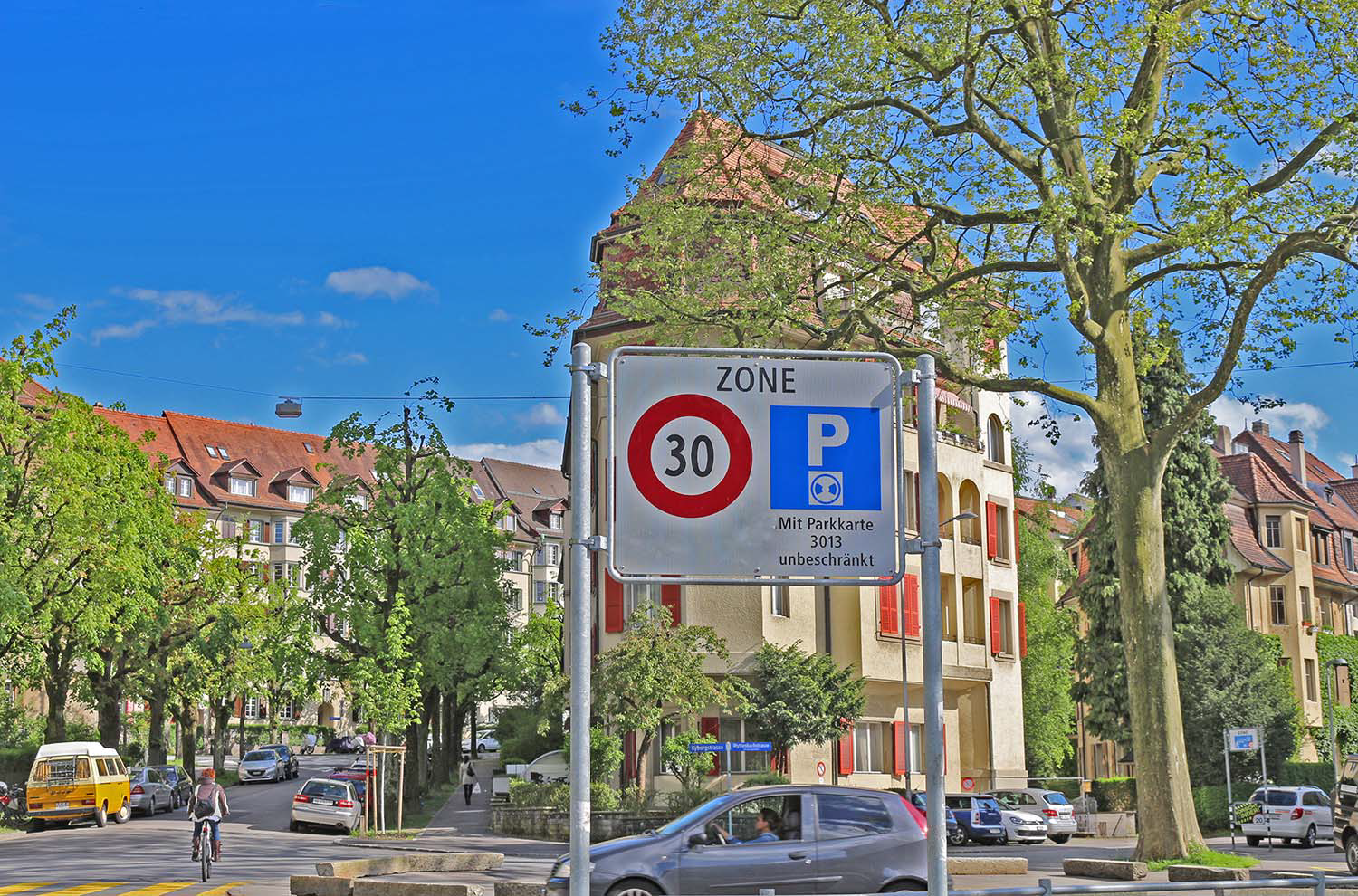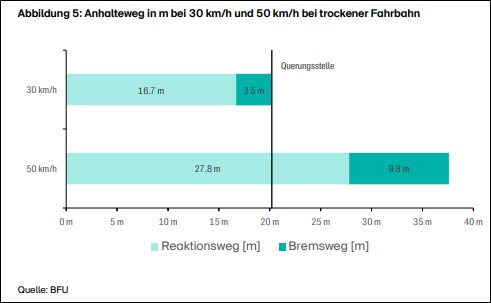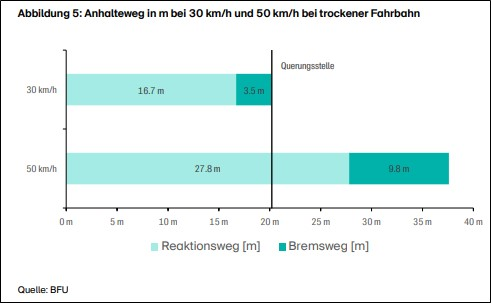Reducing speed lessens road noise right where it is generated. If, for example, the speed limit is reduced from 50 to 30km/h, this has the same effect on noise as if the traffic volume were halved.

Speed reductions lower noise pollution, reduce noise peaks (high sound levels) and increase road safety. This improves the health of nearby residents, particularly as their sleep is less disturbed during the night. The impact of speed reductions on noise levels can be increased by laying low-noise surfaces on sections of road where speed restrictions have been introduced.
Reducing speeds to 30km/h
- Reducing the speed limit from 50 to 30 km/h can lower the average noise level by around 3dB(A). In acoustic terms, this is equivalent to halving the traffic volume.
- Particularly disruptive noise peaks from individual vehicles occur much less frequently, reducing the number of times nearby residents wake up during the night.
- At 30km/h, traffic is free-flowing, as less braking and accelerating is required. The traffic flow becomes more even, and all road users behave more carefully and respectfully towards each other.
- At 30km/h, the majority of motorists drive in third gear, which helps to reduce noise.
- Simple signage is all that is needed to implement a 30km/h zone or section of road; no structural components are required.
- The results of a study in the city of Zurich confirm the positive impact: the people surveyed felt less bothered by noise at 30km/h than at 50km/h, reported significantly fewer sleep disturbances and felt the roads were considerably safer.
Assessing proportionality
If road noise exceeds legal limits, the authorities can take steps to reduce it. One possible way of doing so is to lower the speed limit. Before this kind of measure can be introduced, however, the authorities must check whether it is proportionate in accordance with both environmental law (EPA, NAO) and road traffic law (RTA, RSO), i.e. whether the benefits justify the restrictions.
The following document combines these two legal frameworks and describes the steps for assessing whether speed reductions are proportionate.
Diagram – Proportionality assessment for 30km/h speed limits (PDF, 942 kB, 15.08.2024)In accordance with FNAC 2015, FOEN 2020
Assessment method
To assess whether a speed reduction is proportionate, its impact needs to be evaluated. The FOEN recommends using the following method to analyse the positive and negative effects of lowering speed limits to 30km/h.
Best practice list
The following list contains examples of 30km/h zones and road sections that have led to a perceptible reduction in road noise.
Combined noise protection measures: 30km/h speed limits and low-noise road surfaces
If speed limits are reduced from 50 to 30km/h on roads with conventional surfaces, the average noise level can be reduced by around 3dB(A). The effect of speed reductions is somewhat less pronounced on low-noise surfaces, however, because rolling noise volume is already significantly reduced by these surfaces.
Overall, a combination of these two measures lowers noise by around 5dB(A), although this figure varies depending on the composition of the traffic.
Wirkung kombinierter Lärmschutzmassnahmen Tempo 30 und lärmarme Strassenbeläge (PDF, 4 MB, 10.05.2022)Im Auftrag des Bundesamtes für Umwelt (BAFU).
Evaluation de l’effet sur le bruit de la limitation de vitesse de 50 km/h à 30 km/h et de la pose d’un revêtement phonoabsorbant (PDF, 2 MB, 09.05.2022)Im Auftrag des Bundesamtes für Umwelt (BAFU).
Nur auf französisch verfügbar.
Additional benefits of speed reductions
30km/h zones promote community cohesion and encourage development within urban areas, in turn increasing the attractiveness of towns and cities.
Speed plays a huge role in road accidents. The higher the speed, the longer the thinking and braking distances. To give an illustration: A vehicle travelling at 30km/h comes to a standstill around 20 metres after the brakes are applied. By contrast, a car travelling at 50km/h in the same situation comes to a standstill after around 37 metres.
At low speeds, cyclists and pedestrians in particular are more likely to survive a collision with a car. Only three out of ten people survive when the car is travelling at 50km/h, compared with nine out of ten at 30km/h.
If the design of the road allows it, street
lighting can be dimmed, which saves energy.
Further information
Law
Environmental Protection Act (EPA)
Noise Abatement Ordinance (NAO)
DETEC Ordinance on 30km/h Speed Zones and Pedestrian Priority Zones
Traffic Regulations Ordinance (TRegO)
Federal Supreme Court judgment re Zug (de)
Federal Supreme Court judgment re Basel (de)
Federal Supreme Court judgment re Zurich (de)
Links
Last modification 23.05.2024







